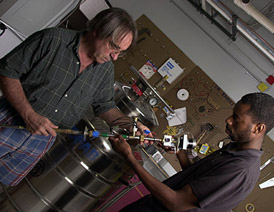
Jim Brooks (left) and Kevin Storr work on a condensed matter experiment.
Condensed matter physics is the science of stuff. The stuff can be made out of carbon, silicon, water, oxygen, whatever, usually in the solid form. They used to call it solid state physics. Stuff is good for various things. You can make transistors, you can make computer chips, you can make microphones, transducers, sensors.
The Magnet Lab is at the early stages of stuff development. In other words, many of the scientists here are looking at new kinds of – I'll call them materials now, to use a fancy word – that may have promise for various applications in motors or electrical transmission or information technology. We're looking at the fundamentals of how these things tick. How the electrons move through them, how their atoms wiggle or vibrate, temperature, what happens when you shine light on them. Or do they give off light when you put electricity through them? Also, small chips of stuff are tortured in very intense laser beams, microwave cavities, under extreme, almost geological pressures. Sometimes, doing experiments like that, you learn the mechanisms: What makes them do this? Once you know that, then sometimes you can fine-tune how you make your stuff and how you process it into a useful device.


